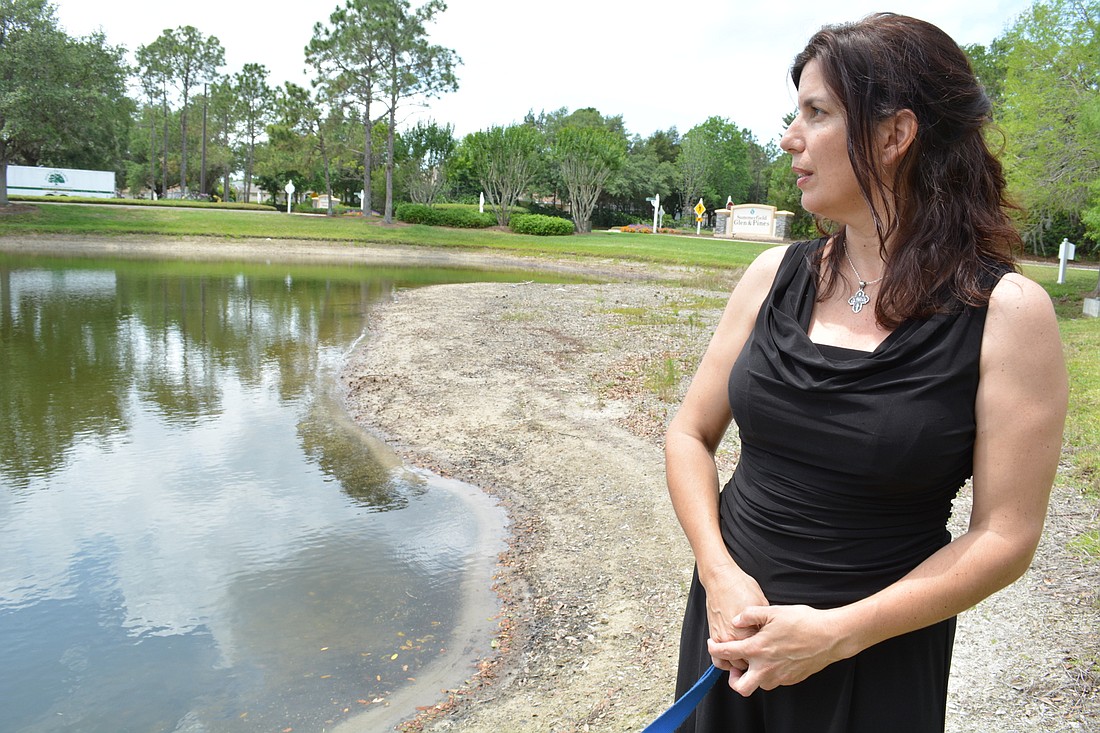- May 10, 2024
-
-
Loading

Loading

Lakewood Ranch resident Maureen Flaherty stepped toward the pond behind her home and pointed to its bare, sandy edges.
“This is the first time I’ve had beachfront property,” she said with a laugh.
Water levels in the Summerfield pond are lower than she ever remembered since purchasing her home in 2003. Flaherty doesn’t mind the pond is no longer aesthetically pleasing, but she worries about the
impacts to wildlife and nature.
“You would never see this before,” Flaherty said. “I think this is a sign there’s a problem. When you hear someone say there isn’t a drought, this is quite the picture.”
The Southwest Florida Water Management District, the agency tasked with meeting the area’s water needs and protecting and preserving water resources, on April 25 extended its Phase 1 water shortage program for its 16-county region, which includes Manatee and Sarasota counties. The Phase 1 shortage alerts the public that watering restrictions could be forthcoming and also requires local utilities to review and implement procedures for enforcing year-round water conservation schedules.
It does not change allowable watering schedules.
Florida’s dry season runs from October through May, with April usually one of the driest months.
Granville Kinsman, the hydrologic data manager at SWFWMD, said the district has experienced “good” rainfall for the past four years, bringing water levels up. Last year proved especially wet, making this year’s dry spell seem more extreme.
“Since Oct. 1, we’ve only received half of what we would normally expect during the dry season,” Kinsman said. “We’re 10 inches below average for the seven-month period. It’s like everything shut off.”
Even still, groundwater levels in the area scored a 16% of 100% capacity. That figure sounds low, but normal for dry season is between 25% and 75%, so the level, although outside that range, does not constitute a “drought” per the water management district’s definition, Kinsman said.
“We live in a system that depends on rainfall,” Kinsman said. “That’s the nature of our state. We’re in a period where rainfall is reduced. There’s nothing really we can do about it.”
Climate models suggest the state will go back into a wet weather pattern later this year, improving chances for above-normal rainfall headed into the winter season, Kinsman said.
He said increased rain is expected to start in June.
Until then, communities are doing their best to weather the dry season. Managers and engineers for East County communities report water levels for many retention ponds are the lowest they’ve experienced, even lower than in 2011 when a drought forced the water management district to dictate once-a-week watering.
“I’m seeing some places where it’s lower now than it was back then,” said engineer Rick Schappacher, the district engineer for the GreyHawk Landing, Harborage, Tara Preserve, Heritage Harbour and Waterlefe communities. “It depends on the exact area. For Heritage Harbour, there are a few lakes you could basically walk across with one little stream in the middle. They said they’ve never seen it that low.”
Paul Chetlain, director of operations for the Lakewood Ranch Inter-District Authority, agreed.
Residents, he said, have expressed concerns about aesthetics, as well as water quality issues. Lower water levels have resulted in algae and other sentiment getting into irrigation lines and sometimes blocking valves and rotors for irrigation systems.
Operations staff flush irrigation lines about once quarterly, but they have had to flush more frequently in some areas to ensure irrigation lines are working properly, Chetlain said.
The retention ponds’ primary role is to collect water runoff from yards and roadways and treat that water before it enters the next water body, stream or river. But they also are used in many neighborhoods for irrigation water.
Schappacher said dry ponds create the potential for erosion. Exposed edges around the lakes — particularly ones that are not vegetated — will erode much easier after heavy rainfall occurs.
Schappacher said he is using the dry spell as a chance to better inspect the ponds in the communities he services so they can better plan and budget for any future repairs.